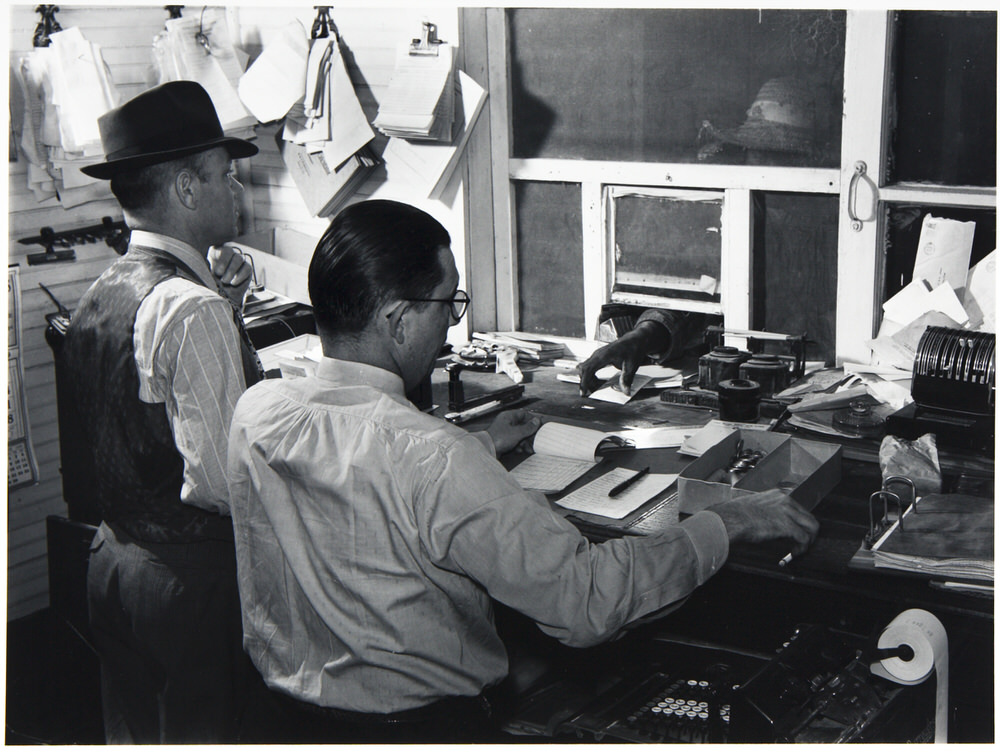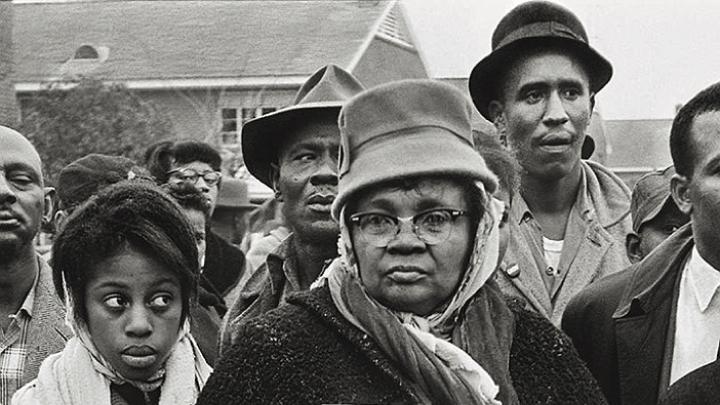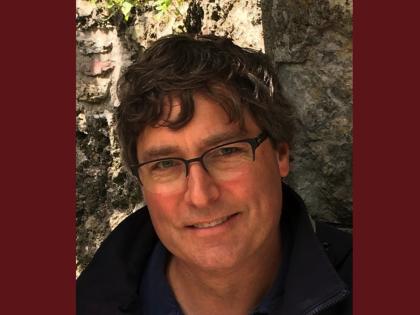American photography shaped the civil-rights era, compelling the nation to see what it had refused to see previously. “It was absolutely pivotal,” says Makeda Best, curator of photography at the Harvard Art Museums. “It was how many Americans came to see what segregation meant and how it was lived.” A selection of 31 photos from the museums’ collections are now on display in the Carpenter Center for the Visual Arts exhibition “Time Is Now: Photography and Social Change in James Baldwin’s America.” The images, spanning 1932 through 1989, trace Baldwin’s life and the questions that most concerned him—including the persistence of white supremacy, and matters of sexuality and religion—through scenes of everyday life, segregation, and resistance.
Most of the photographs depict unnamed subjects, reflecting the writer’s interest in ordinary people’s experience of racism. A striking image greets viewers as they enter: Two white cashiers, their backs toward the photographer, face a window fronting their desks. Through a tiny opening, a brown hand reaches in to collect a payment. “Cashiers Paying Off Cotton Pickers, Marcella Plantation, Mileston, Mississippi,” was taken in 1939 by Marion Post Wolcott, a young photographer for the Farm Security Administration, the New Deal agency that documented poverty in the rural United States. “To me, the one hand references the whole history of inequality,” Best said in an earlier interview. “It’s a hard image.”

Before working on “Time Is Now,” Best says, “I hadn’t thought about Baldwin and American documentary photography as a parallel discussion.” But the two are linked by their shared devotion to telling the truth, to making urgent and undeniable what was once invisible. Baldwin wrote in his essay “The Discovery of What It Means to Be an American”: “The time has come, God knows, for us to examine ourselves, but we can only do this if we are willing to free ourselves of the myth of America and try to find out what is really happening here.” But photographers, like Baldwin, did not merely record; their compositions also contributed to the public imagination their own visions of what America is.
The exhibition proceeds chronologically. Some photographs —like Steve Schapiro’s famous 1965 image “Stop Police Killings, Selma”—could be contemporary, reflecting their continued urgency and the enduring skill of their artists. Other images are less well known, and are being exhibited for the first time. Photographs from the 1970s and ’80s offer a postscript to the civil-rights movement: in one, two men sit in front of a mural in St. Louis, depicting black intellectuals and artists, including Baldwin, Ray Charles, and Frederick Douglass. Above them a caption reads, “Up, you mighty race,” a Marcus Garvey quote. In another, a motorcycle passes a New Haven building graffitied “FREE THE PANTHERS!”
Only one photo of Baldwin, standing with a wry expression outside the “Colored Entrance Only” of a New Orleans ice-cream parlor, is on display, but alongside the images are glass cases containing Baldwin ephemera, like early editions of his books and plays, and the 1963 issue of Time with his portrait on the cover. “A tiny slice of his extremely prolific career,” Best says, meant to display his international stature.
“Time Is Now,” on view in the Carpenter Center’s small, enclosed Sert Gallery and presented without the contextual labels visitors may expect, provides a focused and intimate experience, different from how they might experience the images in a museum gallery. The photographers were also each significant in their own right, Best says: it would have been difficult to tell their stories in addition to those of Baldwin and twentieth-century America.
From a viewer’s perspective, the spare exhibition offers space for reflection, inviting visitors to move back and forth between the photos and Baldwin’s texts. It also encourages viewers to look closely—to be, as Baldwin was, observers of the ordinary. “I’m not telling people how they should read Baldwin,” Best says. The layout of the images, she explains, was also inspired by his writing: “Baldwin was very influenced by African-American music traditions—I wanted the idea of musical score to graphically guide the exhibit. The images move up and down the walls, and they cluster in the ’60s, where the big moment is.”
The exhibition complements Teresita Fernández’s art installation Autumn (...Nothing Personal) in Harvard Yard, inspired by Baldwin’s essay “Nothing Personal.” The sculpture provides a space for dialogue, events, and performances—an answer to Baldwin’s observation that lies are able to fester when people are too distrusting to talk honestly to one another. “The exhibition explores the kind of everyday moments Baldwin wrote of so eloquently. I think the sculpture similarly encourages and elevates what everyday conversation can do for all of us. We don’t need a big forum; we don’t need a special moment. We just need to come together in a space and sit down,” Best says. “I hope people go back and forth between the exhibition and Teresita’s installation, and reflect on them together.”








